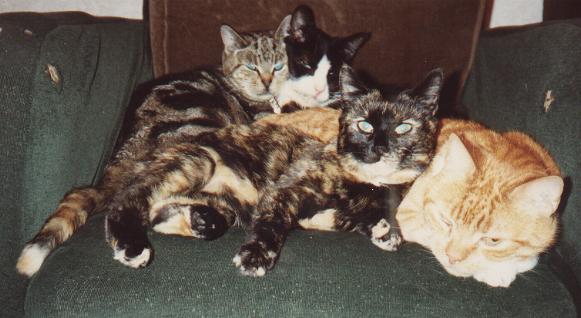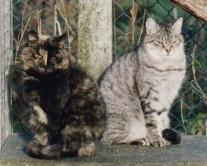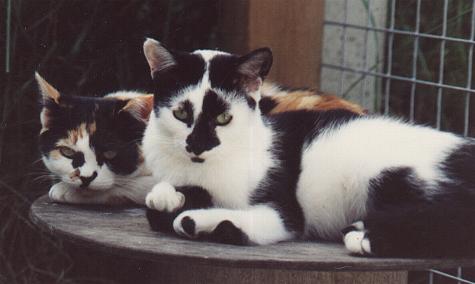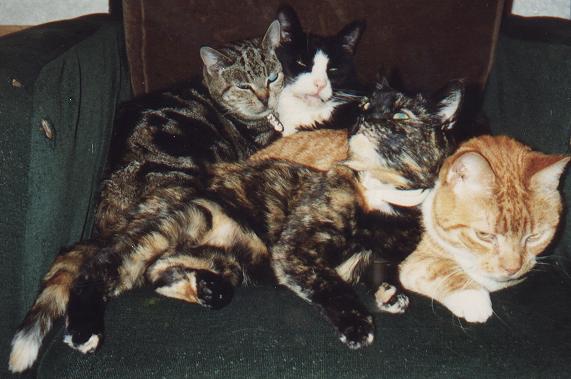
THE UNSOCIABLE CAT - ARE CATS REALLY UNSOCIABLE?
Are cats really as unsociable as we think? Studies over the last thirty years suggest that cats develop complex and fluid matriarchal hierarchies and that they have preferred buddies
For years, 'experts' have told cat owners that domestic cats are solitary creatures who dislike the company of other cats. No doubt cat owners have viewed the communal sleep heap on the armchair with puzzlement, wondering whether it is the cats or the experts who have their facts wrong. Mostly it seems that the 'experts' are judging feline sociability by comparing them to dogs. The separate article Are Dogs More Faithful Than Cats compares some aspects of feline and canine behaviour. Despite increasing evidence to the contrary, many members of the scientific community still stereotype cats as non-social purely on the grounds that they do not form dog-like packs.

As a result, cats are frequently labelled "standoffish", "solitary", "asocial" or "unsociable" suggesting that they just don't like company. This supposed aloofness appeals to some people, but not to others - leading people to be classed as either "cat people" or "dog people". In return, dogs are often viewed as mindlessly obedient and subservient to their pack leader - to the point of being loyalty to a cruel owner (see
Are Dogs More Faithful Than Cats for a disturbing example of this). Feline "aloofness" can create or contribute to anti-cat feeling. This misunderstanding of feline behaviour and persists into modern western society - a recent film called "Cats & Dogs" does cats a great injustice by depicting them as devious and villainous.THE THREE SOCIAL FELIDS - LIONS, CHEETAHS AND DOMESTIC CATS
Scientist long considered the lion to be the only truly social cat. This is because lions form easily recognised prides which superficially resemble the familiar pack behaviour of dogs. Lion prides are harems of related females and their cubs, ruled over by a single male or two or more brothers. The resident males fight intruding males to keep their territory and harems and may be deposed. Male offspring are driven away when they reach maturity. The females generally remain in the territory. Intruding females risk being killed by a territory's resident females. Communal cub-rearing increases the cubs' chances of survival while communal hunting allows the lionesses to bring down prey larger than themselves.
More recently the cheetah has been recognised as being a social creature. Cheetah brothers form alliances with each other and may take solitary females hostage until she is receptive to being mated. All of the brothers will mate with her over a period of days. Male cheetah siblings have been seen to rest and to hunt together. Until recently this was viewed as juvenile behaviour persisting into adulthood and was thought to be a behavioural aberration. However, cheetah alliances have been seen often enough that this is known to be a normal behaviour.
Only in the last few decades have domestic cats been recognised as social animals (at least by scientists). Previously they were seen as little more than multicoloured, tame versions of their solitary African wildcat ancestors. While the ancestors of our domestic cats may have been solitary hunters in the forests of Europe and Africa, domestic cats frequently live in harmonious groups; playing, sleeping and even hunting together. Many form close attachments to other cats and even to other domestic animals.
WHAT IS A SOCIAL SPECIES?

A social species is defined as one which forms "stable relationships". This sort of relationship is frequently seen in feral colonies and in households. Some argue that cats in these situations are displaying unnatural social behaviour due to their enforced proximity to each other, e.g. feral cats attracted to a food supply. Others argue that neutering turns an solitary creature into a sociable creature. However, clear social behaviour is observed including communal rearing of kittens by some females and co-operative hunting. Communal kitten rearing is also seen among household domestic cats.
It has been suggested that keeping several cats in one household forced them to become more sociable due to the unnatural conditions. Certainly, some cats are solitary by nature (just as some humans prefer their own company) and show signs of stress when there are too many cats in a too-small area. Other cats simply tolerate their fellow lodgers and work individual territories within the household. A good domestic cats actually thrive on feline companionship though they do like to be able to retreat to a private area at times (just as humans need moments of solitude).
Back in the 1970s, studies viewed colonies of cats as no more than individuals drawn to a common food supply and tolerating others in the same general area. The attraction of food outweighed the cats' instinct to drive other cats away. Though it seemed that the colony as a whole was territorial rather than any individual cat, interactions between individual colony members were subtle and easy to miss. The absence of dog-like social behaviour told the world that cats were unsociable creatures. Owners disputed this finding, but to no avail.
Contradicting these views is the fact that related females in colonies may be so closely bonded that they will den together when giving birth, will act as midwife to each other and will nurse each other's kittens and show little or no favouritism towards kittens. The hungry kittens would simply feed off of the most available female. Cat owners and cat breeders have also observed this behaviour. In addition, the mothers were seen to join forces to drive off intruders including marauding tomcats which might have killed the kittens in order to bring the females back into oestrus (sexual receptiveness).
The increased popularity of cats as pets led to an increased interest in their behaviour ... and into a whole new branch of companion animal studies - that of the Pet Behaviourist (the "Pet Shrink"). In the thirty years since those early studies, observation of feral colonies and multi-cat households has shown that domestic cats, like lions, are rather sociable creatures and even battle-scarred tomcats will return from walking alone to relax with the family.
RUBBING HIERARCHIES AND BUDDY SYSTEMS
Cats in captive colonies at animal shelters, often form close friendships which last for many years. Eagle shared an enclosure with 11 other 'unhomeable' cats. The other cats frequently rubbed against Eagle and chose to sit close to him. When Eagle died, the relationship between the other cats broke down and the colony fragmented into several small groups. The super-sociable Eagle had been the glue that held them together.

Cats rub against their companions to mingle their scents and reinforce the bond. Biologists studying farmyard colonies noticed that lower ranking cats often rubbed against higher ranking cats. Rubbing also has a hierarchical function and a cat's social standing can be measured by the number of times other cats rub against it. When our cats wind round our ankles it is more than an affectionate greeting; they are letting us know that we rank higher than them. Maybe it's time to worry when Puss DOESN't rub round our ankles.
As well as the "rubbing hierarchy", later studies showed that some cats consistently choose to rest in close proximity to certain other individuals, but not close to certain others. Cat social structure was observed to be matriarchal, a little like a lion pride. Related females were more likely to socialise with each other than are unrelated females. Neutering has removed some of the distinction between male and female, with neutered males being happy to rest together. In a household, two unrelated cats who have lived together since kittenhood can be viewed as "related". Cats favour members of their own family - either their natural family (in a wild situation) or their adopted family (in a household).
This favouritism actually makes sense in terms of survival. Related cats share many genes. In the theory of the selfish gene, favouring closely related individuals ensures that at least some of your own genes survive and get passed along even if it is via a relative rather than your own offspring. I have seen a number of cases where a mother and daughter have reared later litters communally.
Rubbing, nose-bumping greetings and sitting close to other members of the cat's 'family' are not actions caused by keeping cats in 'unnatural proximity' to other cats. All of these activities have been observed among cats living in feral colonies. Behaviourists studying both urban and rural colonies found that the cats formed 'family groups' rather than remaining solitary. It is easy to dismiss this as several cats exploiting a single food source, but the amount of mutual grooming and even communal kitten-rearing suggest that these colonies are more like prides of lions. Communal hunting is only rarely observed since, unlike lions, cats hunt prey smaller than themselves.
Originally it was thought that female cats were sociable with related females, but not with related males. Studies of suburban cats disproved this. Females are equally sociable with their male relatives. Among unneutered males there is the problem of territoriality and competitiveness, though neutered males are often as sociable as females. Even this is not a hard and fast rule as I have found unneutered related tomcats (siblings or those raised together from kittenhood) to form alliances which persist into adulthood (though I have also seen these alliances break down permanently due to stress factors such as competition over females or food).
Hours of observation by researchers showed that cats have preferred "buddies". In neutered colonies, the feline buddy system is not restricted to closely related cats and there seem to be no gender preferences. In household cats, the buddy system is such that cats might "pop in" to visit buddies in neighbouring houses and some will even wait for a feline friend to be allowed out to play. A few owners report that their cats positively encourage neighbouring cats to visit and seem to think "the more the merrier".
SURVIVAL OF THE FRIENDLIEST
Cats have evolved during their long association with humans. Only those cats which tolerated human company went on to rear kittens in close proximity to humans. Living close to humans means living close to other cats as well. Over hundred of generations, those cats best suited to living in feline colonies have reproduced most successfully. Our present day domestic cats are descended from these socialised cats. Feral cats are descended from domestic cats and though they are not socialised with humans, they are still social with other cats. This "selection for the friendliest" means that modern domestic cats have evolved a long way from solitary wild ancestors in behavioural terms. In some pedigree breeds, sociability is considered an important characteristic e.g. in the Australian Mist, unneutered tomcats will live together harmoniously in small all-male groups.
The length of time we have been selectively breeding cats is described in
Are Dogs More Faithful Than Cats. Basically dogs have been selectively bred for certain tasks over a much longer period of time, giving much longer for their social behaviour to be modified through selecting for specific traits. Cats have only been selectively bred for just over a century.|
These two ferals are cheek rubbing to mix scents and reinforce their group membership. |
|
These two ferals first greet each other by stretching and then by rubbing and tail-twining to mix scents to reinforce their bond. |
CO-OPERATIVE HUNTING
Even co-operative hunting does sometimes occur with closely bonded cats. Littermates Bubble and Squeak were two such hunting partners. Between them, they quartered the field in front of my home, flushing out field mice for each other and often sharing the catch. 12 year old Scrapper regularly teamed up with unrelated 6 month old Aphrodite to hunt the birds that devastated my fruit bushes. This was a beneficial partnership as Scrapper, who had no teeth, flushed birds towards Aphrodite who despatched them, but didn't eat them! There was no doubt that Scrapper masterminded the operation as Aphrodite was not very bright!
Discussions with cat-owning friends have provided many more accounts of cats which flushed prey from flower borders into the waiting paws and jaws of the cats they lived with.
In 1996, studies of cats in the Galapagos Islands indicated that some cats will hunt co-operatively to increase the likelihood of successful hunts. This observation was made when prey was difficult for a single cat to catch. At the cat shelter where I work, ferals Kim, Jade and Gem (littermates) did not hunt as a group but they frequently shared their kills.
MALE COMPETITIVENESS
In a three year study of unneutered female ferals the ability of high ranking males to monopolise the receptive females depends on the females' pattern of oestrus ("heat"). Where many of the females were on oestrus around the same time period, a single male cannot monopolise them. While he is mating with one calling female, his competitors can seize the opportunity to mate with the others. DNA studies showed the kittens to have been fathered by different males (the kittens in a single litter may all have different fathers). Where the females came into oestrus over a longer period of time so that only a few were sexually receptive at any one time, the tougher males were able to dominate the supply of receptive females and some of the males fathered no kittens at all.
Many cats, both feral and domestic, apparently enjoy each other's company for its own sake and not just because there is safety in numbers. Though unneutered tomcats are often hostile towards each other, there are exceptions where toms which have been reared together may remain companionable when mature - supply of food and females permitting. Unlike dog packs, there is no alpha male or alpha couple. The fittest, meanest tomcat may get to mate first with the females, but he must usually fight for that right. In addition, females have been seen to reject victorious tomcats and to mate with the loser!
It is possible that the more sociable males will tolerate, to some extent, other males in the proximity of receptive females. They are more likely to tolerate males who, in turn, tolerate them. Often the presence of several sociable resident males will deter wandering males from even trying to mate with the resident females. Studies of pets suggest that kittens inherit much of their personality from the paternal side - sociable males produce sociable kittens (Influence of the Father on Kittens' Behaviour). In a colony situation, wandering lone males will be at a disadvantage and father fewer offspring. This is similar to the lion pride where two or three males have exclusive access to females. While the tomcats may not have exclusive access, they will father the most kittens and subsequent generations (male and female) will inherit an increased tendency to sociability. This is purely a hypothesis and there have not been any detailed studies to investigate the shift towards increased sociability.
TERRITORIALITY

A cat's territory must be large enough to support a cat i.e. have enough prey. Where food is abundant, territories are smaller. Where there is a static supply of food, e.g. a rubbish dump, the cats congregate around the found and do not stray far. Where food appears regularly and in one place -as in a household - the resident cats may have no desire to establish a large territory. A study of suburban cats in Canberra indicated a mean range of 17 acres. Some cats went further afield and others remained in their own gardens. In general, unneutered males range the furthest and their territories overlap with the territories of several unneutered females as well as with competing males. Neutered cats usually have smaller territories. As well as territories, cats establish rights of way across the territories of other cats.
Cats also have indoor ranges which also overlap. While some lay claim to an entire floor of a building, others may have ranges as small as a single countertop or chair and will only leave those ranges in order to eat or defecate. Cats with small ranges may be the pariahs, bullied by others if they leave their tiny territory. Some thought should be given to rehoming a pariah into a less crowded household. The population density of indoor cats may be 50 times that of an outdoor colony. I have never had more than 4 cats at a time in my household (not counting feral kittens being socialised and rehomed) . Most of the house is held as common territory but certain favourite spots are defended against each other. For example Motley sleeps at the head of my bed while Cindy sleeps at the foot of it and there is an invisible line which must not be crossed.
Whether indoors or outdoors, ranges are not two dimensional - they include a cat's right to certain vantage points e.g. a garage roof, a fence (this is a raised walkway for cats) and other three dimensional features. Cats also timeshare, one occupying a favourite spot until another cat came along. Territories are generally negotiated with minimal fighting - mostly with hisses, a swat or dab and maybe some yelling until one or other cat concedes the match. This division of territory is relatively peaceful and enforced by body language barely perceptible to observers. Only when one cat tries to expand its holding are conflicts likely to occur.
Upheavals occur when a new cat moves in and must carve a territory, making resident cats adjust their boundaries by force if necessary. When a cat dies, the territories also shift. When Sappho died, her space on my sofa was annexed by Queenie. The rights to the prime feeding spot on top of my fridge were similarly inherited when Aphrodite (undisputed top cat) died and Motley considered herself promoted. Behaviour patterns also change when a cat moves away or dies - this is a subtle reorganisation of social structure among those remaining behind, even if some of those cats had little or no interaction with the one which has vacated the area (scent is a strong factor in this).
Unrelated cats may gang together to defend themselves or their territory against intruders. On one occasion I was woken by Aphrodite and Sappho (twice Aphrodite's age and unrelated); between them they had cornered an opportunistic cat which had come in through the cat flap. Aphrodite guarded one end of the long hallway, Sappho guarded the other end and they played 'ping-pong' with the youngster until I rescued and evicted him.
|
|
|
In our households, unrelated cats often form close attachments to each other and a recent survey by British behaviourist Claire Bessant found that a number of cats grieved or pined when a companion cat died, sometimes to the extent that force-feeding was needed or another kitten had to be acquired to provide companionship. Others gain in confidence as they take over new territory. I nickname this behaviour "dead cat's paws". Some owners feel there is some sort of psychic phenomenon where a surviving cat adopts the deceased cat's behaviour and territories. The real explanation is much simpler - the deceased cat has left behind the rights to certain privileges and the survivor takes over those privileges - no longer kept in his/her place by scent markings and body language that humans simple cannot detect. In particular, the deceased cat's scent fades (it isn't being renewed daily) which tells other cats that there is a vacancy.
SOCIALISATION
How and when do cats develop their social skills? The socialisation period for kittens is between 3 and 12 weeks. There is more in dept information about the socialisation period in the article
Taming Feral Kittens.In 1930s experiments kittens raised alongside rats considered rats as companions rather than prey. Kittens raised with both rats and kittens preferred feline company, but had reduced tendencies to kill rats. However the likelihood of a young adult killing a rat does not mean it will never kill a rat. Cats are complex animals and the hunting instinct may reassert itself at any time during adulthood - and once reasserted, it seems to be reinforced by each kill.

Cats also have personalities or "behavioural styles" i.e. the style of their interaction with other cats, other animals or with people. A small percentage of cats lack the ability to be domestic pets even if born to domestic parents and raised in a household. They simply lack the right mix of genes and are not predisposed to tameness. By observing the same cats over a period of two years, from kittenhood into adulthood, behaviourists can classify cats as shy, bold, friendly, playful etc. Such studies may help in placing cats with families i.e. by having a standard checklist and noting certain key behaviours. How and when do cats develop their social skills? The socialisation period for kittens is between 3 and 12 weeks. In 1930s experiments kittens raised alongside rats considered rats as companions rather than prey. Kittens raised with both rats and kittens preferred feline company, but had reduced tendencies to kill rats. However the likelihood of a young adult killing a rat does not mean it will never kill a rat. Cats are complex animals and the hunting instinct may reassert itself at any time during adulthood - and once reasserted, it seems to be reinforced by each kill.
Behaviourists have found that cats have different personalities or "behavioural styles" i.e. how they interact with other cats, with other animals or with people. Due to the mixture of genes they inherit from each parent, a small percentage (often suggested at around 10%) will not inherit the ability to be domestic pets even if they are born to domestic parents, handled during the socialisation period and raised in a household. By observing a number of cats over a period of several years, from kittenhood into adulthood, behaviourists can classify cats as shy, bold, friendly, playful, confident etc. Such studies and identification of key traits are used by some shelters when matching cats to potential adopters.
SUMMARY
It is only quite recently that experts have started saying what many cat-owners have realised all along - cats are not necessarily solitary creatures. Some require a solitary lifestyle. Others are content to live in small groups, particularly if all of the cats are neutered. Far from suffering when kept in groups, many pet cats thrive in the company of other cats especially if they have grown up among other cats. Its ancestors may have walked by themselves, but the cat has evolved into a far more sociable animal both in a feral and a household setting.